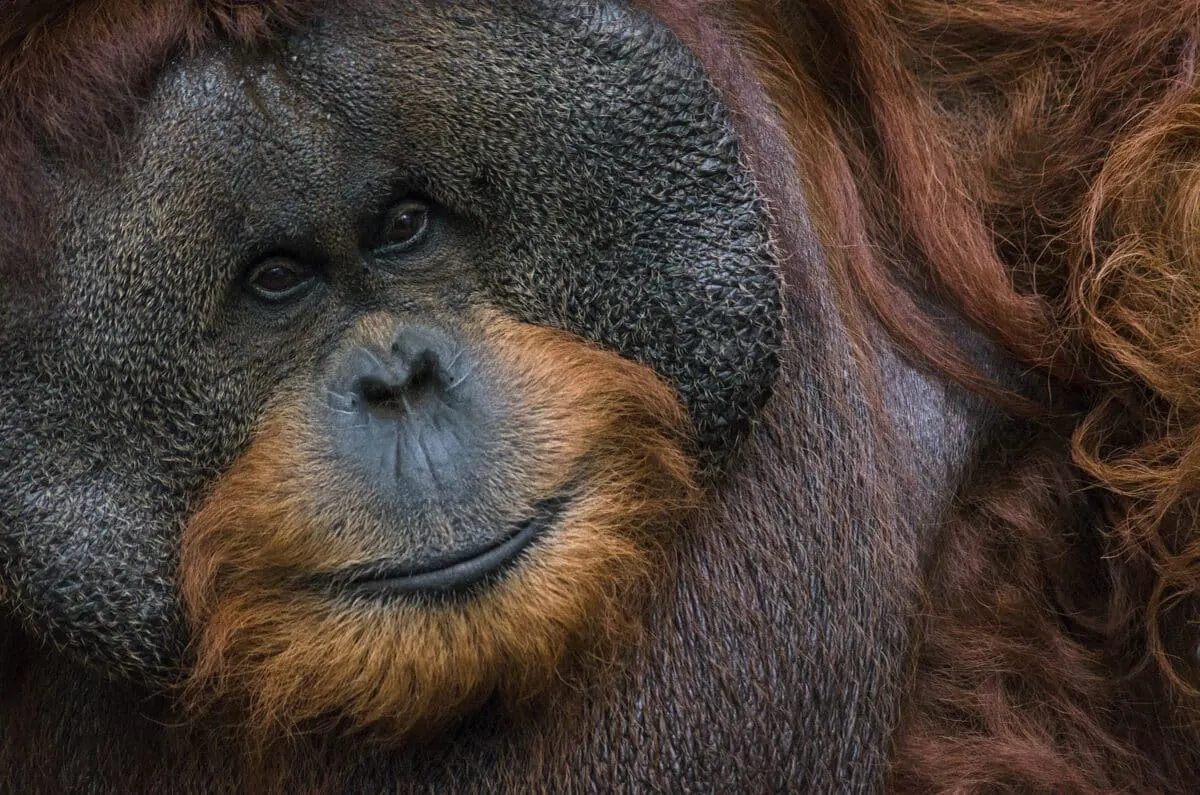Are you looking for the Best Places to See Orangutans? We have searched everywhere for you to find the best places to see Orangutans in the wild.
Orangutans belong to the great apes, along with gorillas and chimpanzees. Surprisingly, orangutans are the only great apes that are not found on the African continent.
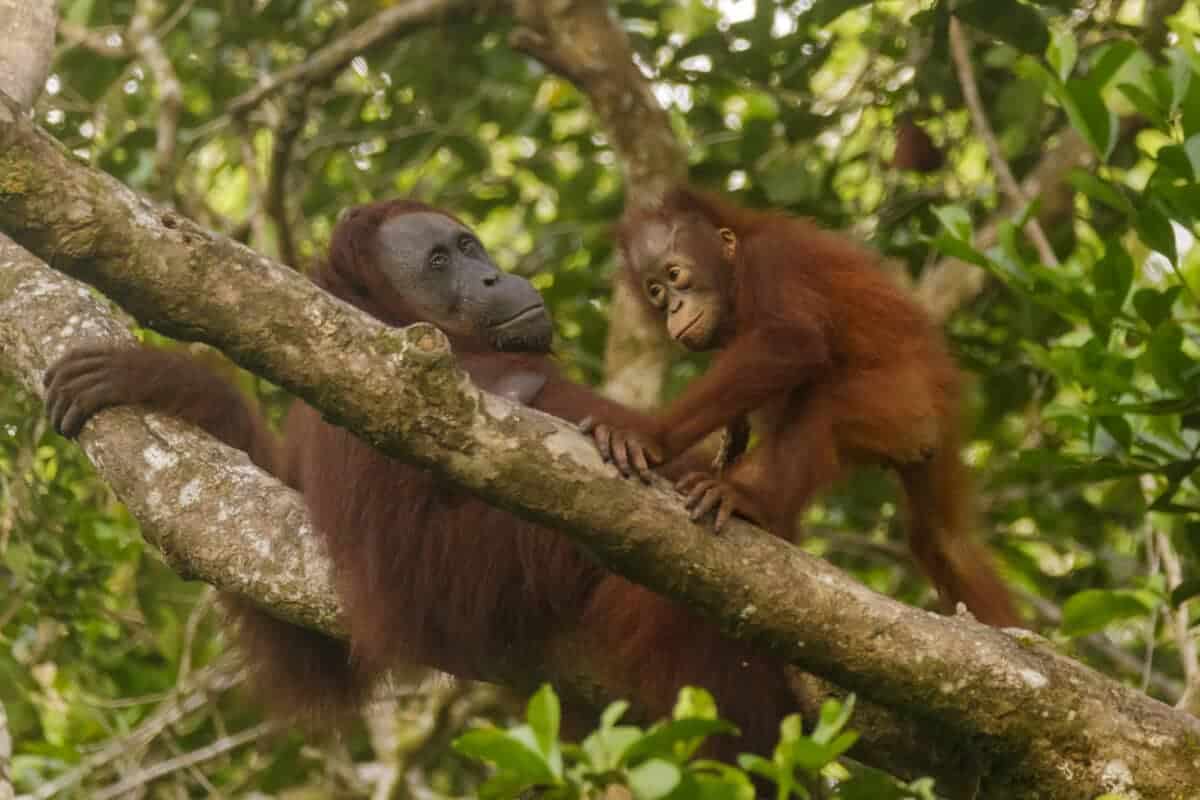
Are you a fan of the African Continent? Look at our blog, All about Mountain trekking with the Gorillas.
In their social behavior, they are very similar to humans and surprise their observers again and again with their behavior: Orangutans grab, brood and even powder themselves.
Visually, the orangutans are the least similar to humans among all apes – and this is what makes them so fascinating!
Key Points:
- Orangutans are part of the great apes family, along with gorillas and chimpanzees.
- They are the only great apes not found in Africa.
- Orangutans are classified as endangered as of 2023.
Just have a look at the outline and jump to whatever part appears as the most interesting one for you.
This article is intended to introduce you to the way of life of orangutans and ultimately to help you admire them up close.
What you need to know about Orangutans
The mental abilities of the red apes of Sumatra and Borneo have long been underestimated. However, their intelligence is only differently oriented but not less than that of chimpanzees and gorillas, their African relatives.
As the largest tree-living mammal species, they use their technical and social ingenuity to exploit the scattered food resources and avoid other species economically.
General Facts about Orangutans
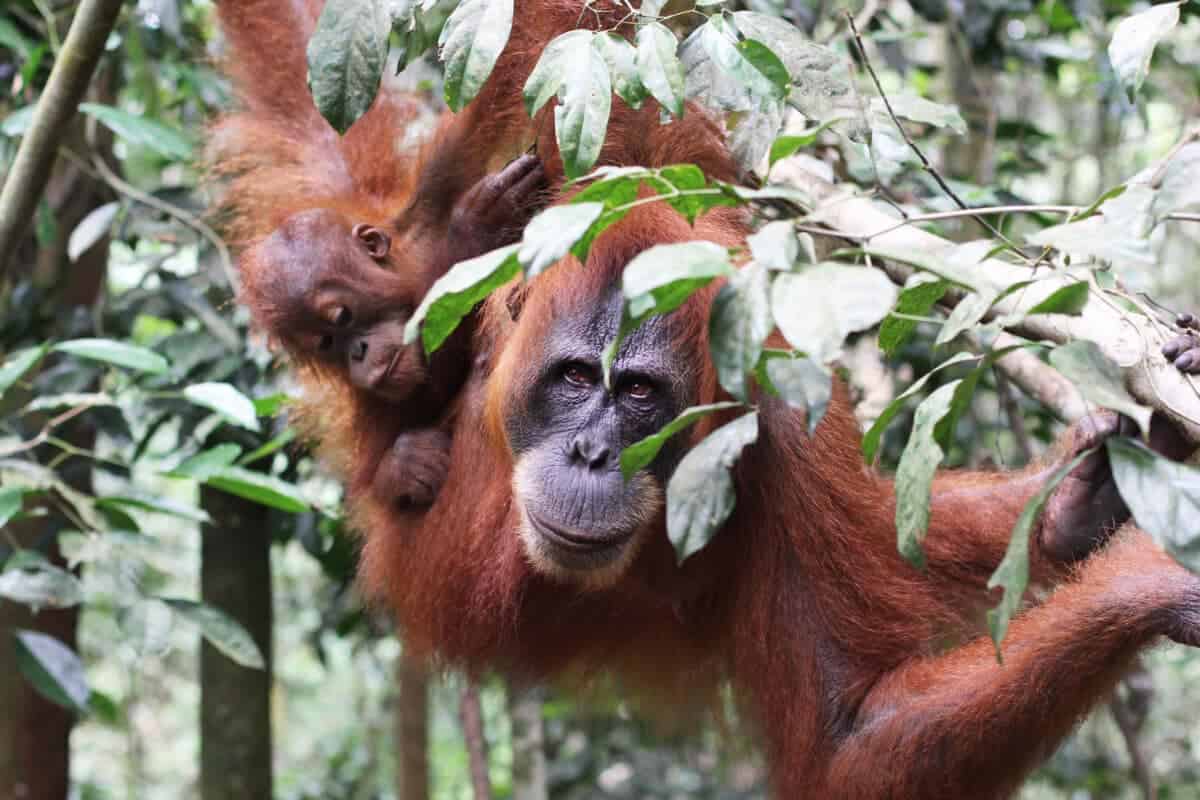
Granted, high up in the trees, you won’t be able to keep up with the orangutans.
Their arms are very long, the hands hook-shaped, the thumb short and close to the wrist, the legs short and very flexible, and the feet hand-like. This physique offers the optimal conditions to move high and freely up in the trees.
Orangutans reach a size of 1.25 to 1.5 meters and have an impressive wingspan of up to 2.25 meters. In terms of weight, there is a clear difference in sexes: males weigh 50 to 90 kilograms, almost twice as much as females, who weigh 30 to 50 kilograms.
A female gets her first young at age 15, which she looks after for up to eight years with close contact. Orangutans give birth to a maximum of four children during their lifetime – one reason why it is so challenging to maintain their population. In the wild, Orangutans live up to 50 years. So there are many Best Places to See Orangutans.
Social Behaviour of Orangutans
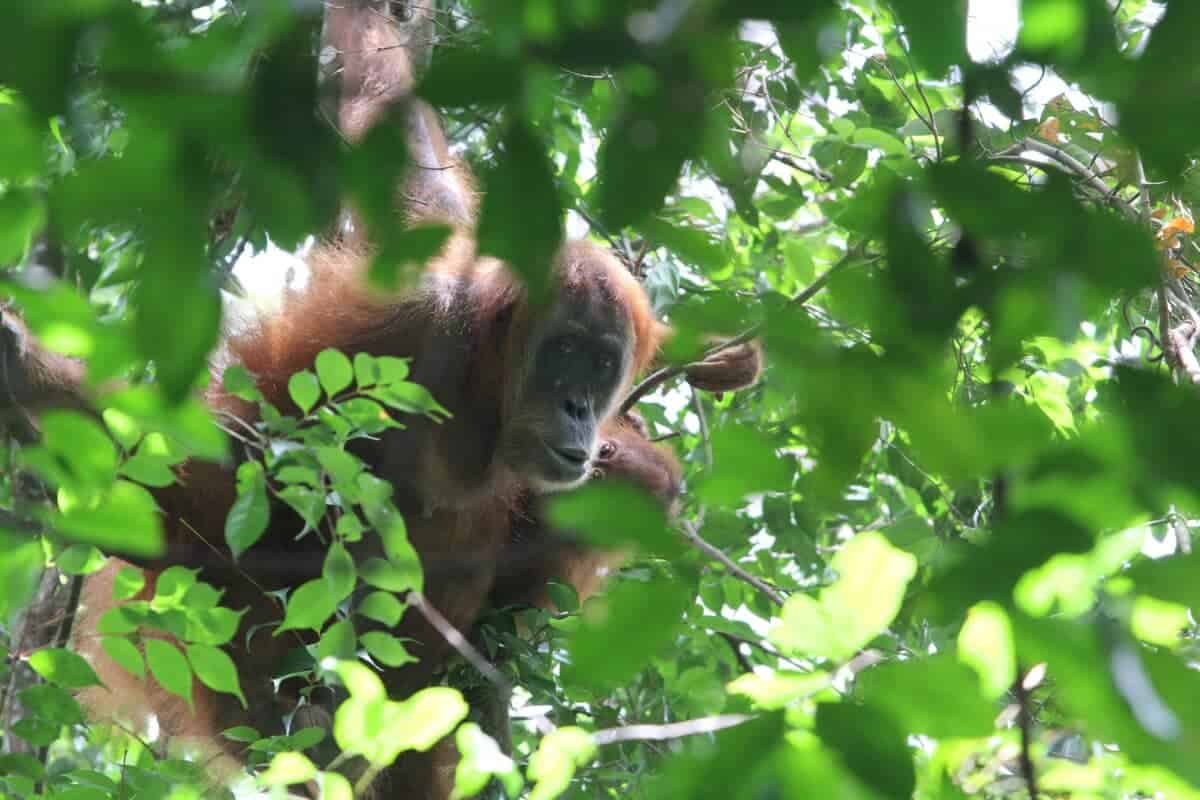
Apart from the close bond between child and mother, orangutans are usually found individually. Interactions between conspecifics take place but are largely unexplored. When two males collide, this can lead to a dispute. The females, on the other hand, behave more peacefully and have even been observed to search for food together, studies show.
Orangutans are quieter than other apes. More noticeable sounds are the loud cries of the males to mark their territory. Little is known about other vocal expressions or communication by means of facial expressions and postures.
Diet of Orangutans
High up in the trees, the orangutans can enjoy the juiciest fruits.
Orangutans have a big appetite. Two-thirds of their food consists of fruits, and they taste the leaves. Occasionally they even ingest soil to regulate their mineral balance. On their menu are not only juicy figs, mangos and lychees but also Durian, probably known to you as “stinky fruit”.
In your search for orangutans, you should look for trees covered with fruit because the clever apes know precisely where to find them.
Best Places to See Orangutans
There are generally three different types of orangutans: Borneo Orangutans, Sumatran Orangutans and Tapanuli Orangutans. All three species live on Borneo and Sumatra, two huge islands.
Tapanuli orangutans were not discovered as a separate species until 2017 and live on the Indonesian island of Sumatra. Their small distribution area can be seen on the map. The species lives in a narrowly limited distribution area, which is a forest area south of Lake Toba. Before the species was biologically defined, the small population of Tapanuli orangutans was counted as Sumatran orangutans.
#1 Borneo
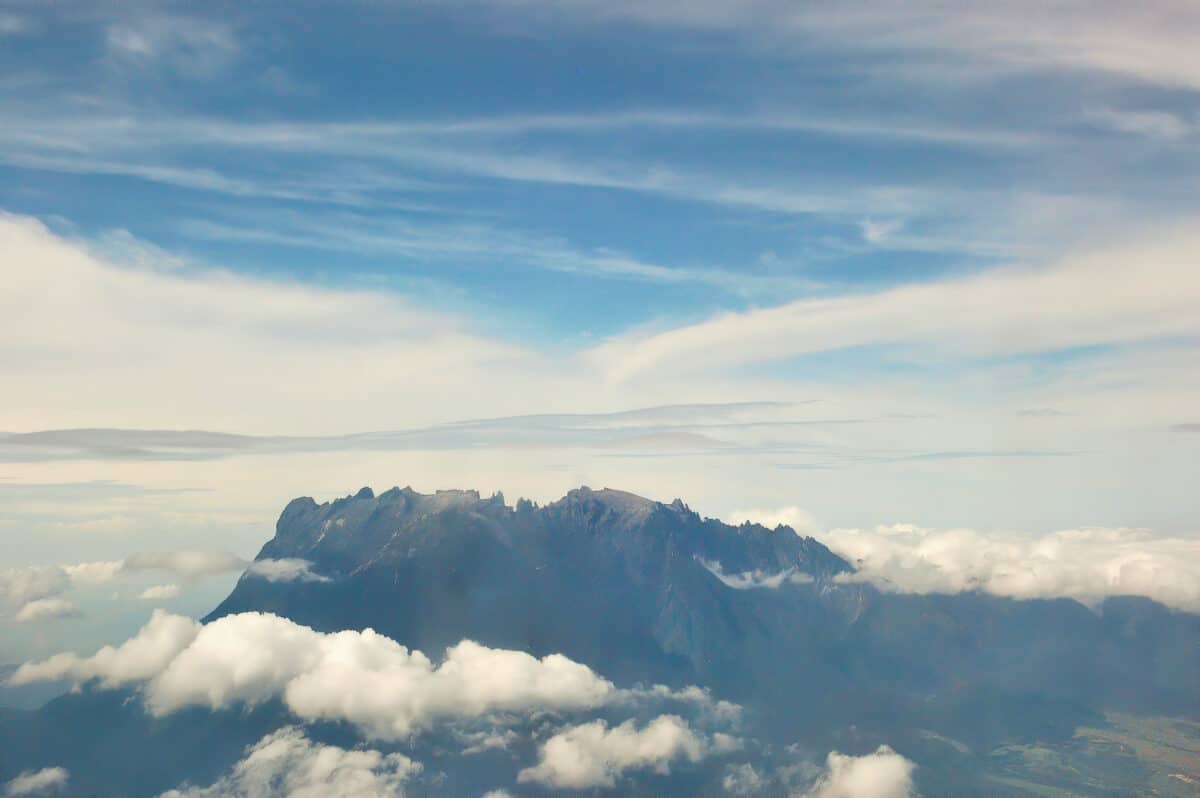
Borneo is home to the largest population of the species of orangutans. It is the third largest island in the world, the largest island in Asia and offers paradisiacal views.
Most of Borneo belongs to Indonesia, other parts belong to Malaysia and even Brunei. The island is cut in the south by the equator and therefore has a predominantly tropical climate with high humidity. On the sizeable southern part of the island, there is no rainy season and the average temperature fluctuates around 27 degrees Celsius. The best time to travel is from March to September. April and July are considered the best months to travel because of the more moderate climate. Another reason why it’s so great to see Best Places to See Orangutans.
On average, the sun shines on Borneo five hours a day. The rainforest on the equatorial island is one of the oldest in the world. There exists a rich treasure of different plant and animal species. Many of these plants and animals are endemic, which means that they are only found in the form of Borneo.
So when you are there, you get to see things that are not found anywhere else. Borneo orangutans for example. Borneo Orangutans can be found best in the south of the island, but even in the northeast of Borneo, you might meet the calm creatures climbing in the trees. A great place Where to See Orangutans.
But, as just mentioned, Borneo is enormous – twice the size of Germany. So how are you supposed to find your way around there and, more importantly: How to climb with Orangutans?
You will probably arrive at the airport of Kota Kinabalu, Malaysia. From there, you can start your discovery tour of Borneo. Kota Kinabalu is the capital of the state of Sabah and the gateway to Kinabalu National Park. Here you will find the oldest rainforest in the world, with an area of 75,370 hectares and a thousand different animal and plant species.
In the middle of it all is Gunung Kinabalu. With 4,095 meters, it is the highest mountain in Southeast Asia. The city is practically surrounded by the rainforest and so the national park is only about 70 kilometers away. This is a stone’s throw away for an island the size of Borneo. The best way to get there is by bus, where you also get to know local people!
You might even spot an Orangutan at Kinabalu National Park if you are very lucky.
Your chance of success with orangutans is probably higher in Tabin National Park. The Tabin Wildlife Reserve is located in the center of the island and belongs to the Malaysian state of Sabah in the northeast of the island. It is closer to the airport of Lahad Datu. Starting from KK, it takes about 45 minutes by plane to cover 270 kilometers.
Other orangutans live in Gunung Mulu National Park and Bako National Park.
The Bako National Park is both the smallest and the oldest national park in the state of Sarawak. It is located in northwest Malaysia on the island of Borneo, about 37 kilometers from Kuching on a peninsula in the South China Sea. The Bako National Park, which was established in 1957, is known far beyond the borders of Malaysia for its boundless diversity of flora and fauna. You can reach the island via a ferry service with motorboats that moor at various points on the peninsula’s beach. From the landing stages, numerous hiking trails lead through Bako National Park, which visitors can explore to their heart’s content.
The Gunung Mulu National Park, included in the UNESCO World Heritage List, is famous for its caves, one of which is considered the most extensive underground hall (the Sarawak Chamber). Another interesting fact when looking for the Best Places to See Orangutans.
#2 Sumatra
It is the sixth largest island on earth, a tropical treasure of life on the equator. Here we can expect encounters with nature and incredible cultural diversity.
Together with Borneo, it is the only habitat for orangutans living in freedom. Pongo abelii (the Sumatran orangutan) shares the island with the Sumatran tiger, Sumatran rhino, Sumatran elephant, Malay bear and about 200 other mammal species. By the way, the Sumatran tiger is a reason for the fact that the orangutan is almost exclusively high up in the trees. Again, Sumatra is a huge island, and it is quite helpful to get an overview of how to climb with Orangutans before you enter the dense tropical rainforests. There are eleven national parks in Sumatra, three of which – the Gunung Leuser National Park, the Kerinci Seblat National Park and the Barisan Selatan National Park – are UNESCO World Heritage Sites. In addition, there are numerous smaller nature reserves such as the Lembah Anai Nature Reserve between Padang and Bukttingi, the Batang Palupuh Nature Reserve and the Harau Valley near Bukittingi or the Way Kambas National Park near Bandar Lampung.
To read more about wildlife that you can find in Indonesia, read this blog post.
#3 Gunung Leuser
The Gunung Leuser National Park is home to about 700 different animal species, including orangutangs, tigers, rhinoceroses, elephants, Thomas langurs, gibbons, macaques, cobras, crocodiles and leopards. It is also home to about 4000 different plant species, including the largest flower in the world, the giant reflower.
Most of the Gunung Leuser National Park is impassable. In addition, one may only enter the Gunung Leuser National Park when accompanied by a trained hiking guide and must obtain a permit in advance. Starting points for tours through the Gunung Leuser National Park are Bukit Lawang, Tangkahan and Gurah. From all three starting points, you can undertake a variety of hikes, ranging from easy walks of several hours to expeditions lasting one or even several weeks. Often the organized hikes, which take place in groups, include overnight stays in the jungle as well as rafting or tubing on the rivers. In addition, some organizers offer pure kayak or rafting tours, night hikes, birdwatching and theme-specific hikes in the Gunung Leuser National Park.
Most visitors choose the tranquil village of Bukit Lawang as the starting point for their hike through the Gunung Leuser National Park, as there they can combine the excursion to the nature reserve with a visit to the famous Bohorok Orang Utang Centre.
Lembah Anai
The Lembah Anai Nature Reserve consists mainly of dense rainforest extending over hills and valleys on approximately 220 hectares of land. If you cross the Lembah Anai Nature Reserve by bus, car or train, you will see unforgettable images: deep gorges, winding roads, massive, high railway bridges, giant trees, a waterfall whose spray shimmers colorfully in the sunlight, and perhaps even wild monkeys.
Endangerment of Orangutans
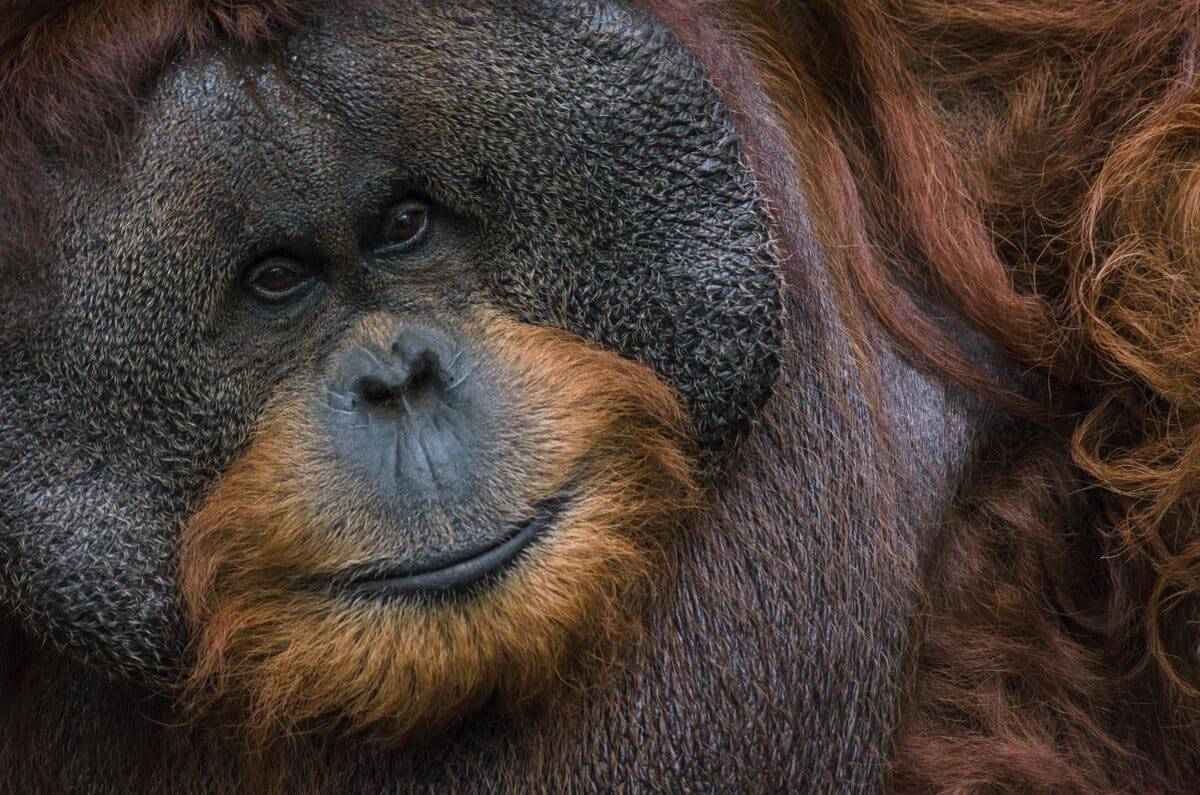
The fact is, these beautiful, impressive animals are threatened with extinction!
The forests are cut down for timber production or to use the area agriculturally, e.g. for palm oil plantations. The orangutans need treetops in the rainforest because this is where they build their nests and look for food. As we have learned before, orangutans have few offspring in the course of their lives. This makes it particularly difficult to maintain populations.
In Java, it has already become extinct, and on Borneo and Sumatra, it is facing the same fate: according to estimates by the World Conservation Union IUCN, there are still around 104,700 orangutans on Borneo and around 13.846 on Sumatra. The WWF estimates that the number of orangutans in Borneo is now much lower, at around 54,000.
To maintain the populations of the great apes, various projects are supported:
- – Reforestation of destroyed rainforest on Borneo
- – Orangutan reintroduction projects
- – Environmental education in Indonesia and Germany
- – Support for the orangutan sanctuary in Pasir Panjang on Borneo
- – Support of the orangutan reintroduction centre in Jantho on Sumatra
On-site, you can visit the different animal protection stations and interact with orangutans.
To read more about other highly endangered species, read this blog post.
Facts about Orangutans
| Category | Information |
|---|---|
| Classification | Orangutans belong to the great apes family, alongside gorillas and chimpanzees. |
| Habitat | Found in the rainforests of Borneo and Sumatra (not in Africa). |
| Physical Characteristics | Arms are long and hook-shaped, legs short and very flexible, feet hand-like. Size: 1.25-1.5 meters. Males weigh 50-90 kg and females 30-50 kg. An impressive wingspan of up to 2.25 meters. |
| Social Behavior | Similar to humans but usually solitary except for the mother-child bond. Males may fight when they encounter each other, while females may forage together. |
| Communication | Quieter than other apes; males make loud cries to mark territory. Little is known about other vocal expressions or communication through facial expressions and postures. |
| Diet | Primarily frugivorous (around two-thirds of their diet). They eat leaves and occasionally ingest soil to regulate their mineral balance. |
| Reproduction | Females give birth to their first offspring at around age 15 and may have up to four during their lifetime. They take care of each child for up to eight years. |
| Endangerment Status (2023) | Critically endangered due to habitat loss (e.g., deforestation for palm oil plantations). In Borneo, the estimated population is around 54,000-104,700, while in Sumatra it is around 13,846. |
| Conservation Efforts | Reforestation, orangutan reintroduction projects, environmental education, support for sanctuaries and reintroduction centers in Borneo and Sumatra. |
| Best Places to See Orangutans | Borneo (especially Tabin National Park, Gunung Mulu National Park, and Bako National Park) and Sumatra (especially Gunung Leuser National Park). |
| Species of Orangutans | Borneo Orangutans, Sumatran Orangutans, and Tapanuli Orangutans. |
| Unique Feature | Orange-red-brown fur color due to sunlight reflected from the fur; in the shade, the dark skin underneath is visible. |
Summary of Best Places to See Orangutans
Finally, we’ll answer a question that is undoubtedly already burning on your fingers: Why are orangutans orange? Also, look at our Gorillas article if you enjoyed reading Best Places to See Orangutans.
The orange-red-brown fur color of the orangutan is a result of the sunlight reflected from its fur. In the shade, their brown skin absorbs the light so that only the dark skin underneath is visible.
FAQs
The best place to see orangutans in the wild is in the rainforests of Borneo and Sumatra, which are the only two islands where wild orangutans are found. Some popular locations include Tanjung Puting National Park in Borneo and Gunung Leuser National Park in Sumatra.
Yes, there are several rehabilitation centers where you can observe orangutans up close. Places like the Sepilok Orangutan Rehabilitation Centre in Malaysian Borneo and the Borneo Orangutan Survival Foundation in Central Kalimantan, Indonesia, provide opportunities to see orangutans that are in the process of being rehabilitated and reintroduced to the wild.
Orangutans can be seen in captivity at reputable zoos and wildlife sanctuaries around the world. Some well-known institutions include the Singapore Zoo, the San Diego Zoo, and the Smithsonian’s National Zoo in Washington, D.C.
The best time to visit for orangutan spotting is during the dry season, which typically occurs from June to September. During this time, the rainforests are less dense, making it easier to spot wildlife. However, it’s essential to check the specific climate patterns of the region you plan to visit, as the weather can vary.
Yes, it’s crucial to be mindful of ethical considerations when visiting orangutan habitats or rehabilitation centers. Choose facilities that prioritize the well-being and conservation of orangutans, and avoid those that exploit or mistreat the animals. Responsible tourism includes maintaining a safe distance from wild orangutans, not feeding them, and following guidelines provided by local authorities and conservation organizations. Additionally, support conservation efforts and organizations working to protect orangutans and their habitats.
Thanks for reading this article on Where to See Orangutans.
Also have a look at Albino Monkeys, Ugly Monkeys or Baby Monkeys. To check out mind-blowing facts about apes, check out this blog post.
- Top 5 Rarest Animals in the World - April 15, 2024
- Mongoose Meets One Of The Deadliest Snakes Alive - April 8, 2024
- Watch: Komodo Dragon Swallows Baby Goat In Seconds - March 28, 2024

